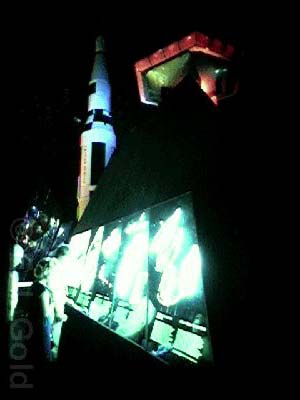 By the time visitors got through with the lower section of the exhibit, they had probably noticed that the environment was pitch black except for lighting coming from the displays and a few strategic emergency lights just to stay ahead of any risk of tripping, but it was rather dark around the escalator and one didn’t know where it was leading. Up the escalator which ran alongside the Saturn 5 rocket model, visitors landed on the mezzanine which was devoted to the explosive theme of UFOs and extra-terrestrial encounters. At the top of the escalator they were greeted on the right by aluminum robots slightly reminiscent of Robbie the Robot, and on their left by a Close Encounter of the Third Kind in the form of a strip of pavement with a creature walking along the road and a UFO hovering above it. This was a very effective exhibit with dramatic lighting and a spooky mood that was already in place before my arrival and stayed there to the end. A classic full of punch that needed only the handy telephones to pick up and listen to for a little background information.
By the time visitors got through with the lower section of the exhibit, they had probably noticed that the environment was pitch black except for lighting coming from the displays and a few strategic emergency lights just to stay ahead of any risk of tripping, but it was rather dark around the escalator and one didn’t know where it was leading. Up the escalator which ran alongside the Saturn 5 rocket model, visitors landed on the mezzanine which was devoted to the explosive theme of UFOs and extra-terrestrial encounters. At the top of the escalator they were greeted on the right by aluminum robots slightly reminiscent of Robbie the Robot, and on their left by a Close Encounter of the Third Kind in the form of a strip of pavement with a creature walking along the road and a UFO hovering above it. This was a very effective exhibit with dramatic lighting and a spooky mood that was already in place before my arrival and stayed there to the end. A classic full of punch that needed only the handy telephones to pick up and listen to for a little background information.
Throughout the display, many different kinds of questions were raised about unidentified flying objects. What were they? A monumental hoax? A military conspiracy? Psychotronic experiments? Geomagnetic disturbances? Mass hallucinations? Archetypal manifestations? Visitors from outer space interfering with this planet? Are we alone? Is life a chance appearance on a lonely planet or the almost inevitable scenario for most solar systems? Is consciousness distributed throughout the Universe? Does a galactic brotherhood exist?As many points of view as possible were explored. No answer accounted for all the facts relating to UFOs, so it appeared their mystery was far from being resolved and should be kept open. The many facets of this disturbing phenomenon invited speculations of all sorts, heated debates, enthusiasm, and uproar. So we held the position of curious observers and tried to see as much as possible.
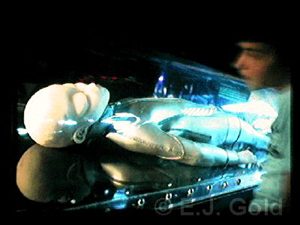 Some famous cases were explored from Betty and Barney Hill to Travis Walton. Exhibits presented a wide range of material, including the categories of Close Encounters of the First, Second and Third Kind. In fact, excerpts from Close Encounters of the Third Kind by Steven Spielberg were presented to a huge success. It was a dramatic addition to the exhibit in my main theatre (there were three theatres in all, aside from smaller projections that were incorporated in display cases), with 20 minutes of the best sequences to enthrall visitors. We even attempted to borrow the model of the Mothership from Steven Spielberg but he had his eyes on the Smithsonian Institution, so we were out of luck on this one. But we weren’t out of luck with our celebrity guests.
Some famous cases were explored from Betty and Barney Hill to Travis Walton. Exhibits presented a wide range of material, including the categories of Close Encounters of the First, Second and Third Kind. In fact, excerpts from Close Encounters of the Third Kind by Steven Spielberg were presented to a huge success. It was a dramatic addition to the exhibit in my main theatre (there were three theatres in all, aside from smaller projections that were incorporated in display cases), with 20 minutes of the best sequences to enthrall visitors. We even attempted to borrow the model of the Mothership from Steven Spielberg but he had his eyes on the Smithsonian Institution, so we were out of luck on this one. But we weren’t out of luck with our celebrity guests.
For its in-season promotional program, Strange, Strange World had one guest speaker during the brief summer season during which it was open, from late June to Labor Day weekend, and in 1978 it was the director of the Center for UFO Studies and former director of the infamous Project Blue Book, Dr. J. Allen Hynek, who had a cameo role in Close Encounters of the Third Kind. Hynek was gaining fame so it was a very nice coup to have his presence in the pavilion and press conference etc. He was quite a hit, as you can well imagine in those days, when this was still relatively new and there was no place else where anything like this could be found in such an elegant manner.
Because of the focus on the new and very handy nomenclature of Hynek, CEI, CEII and CEIII, it was natural to turn to him for participation. He graciously accepted our invitation and came to Montreal for a couple of days. Before Hynek and again prior to my participation, the Heretic among Heretics Jacques Vallee had collaborated, the highly controversial Eric Von Daniken had lectured, as had Carl Sanderson and would later, Stanton Friedman.
Photos of flying saucers, physical traces left behind by unknown sources, eye witness accounts, and even some 3D creatures and humanoids filled every nook and cranny available for light boxes, models and scenes. I had huge light boxes eight-feet high that displayed dramatic transparencies. Betty Hill found herself in a converted thirty-foot aquarium in the middle of the structure discreetly embedded between the up escalator and the down stairs.
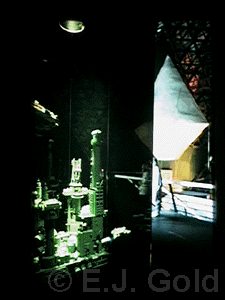 A model of an immense space station from the realms of science fiction was produced by two lively teenagers adept at modelmaking and very bright eyed and bushy tailed. One of them, Joel Champetier, an award-winning science fiction writer today has since become the editor of Solaris, the french language science fiction magazine published in Quebec which, at the time of this exhibit, was edited by Norbert Spehner who was also the official writer for Strange, Strange World whose job I envied years ago but quickly forgot about once I got busy. It was a harmonious collaboration in every way. Norbert, a college professor and founding Solaris editor, was extremely competent and well-informed. He flowed with my slightly new direction, and was brilliant at getting down on paper a synthesis of all I had assembled during my many months of research when I prepared the exhibit during the off-season.
A model of an immense space station from the realms of science fiction was produced by two lively teenagers adept at modelmaking and very bright eyed and bushy tailed. One of them, Joel Champetier, an award-winning science fiction writer today has since become the editor of Solaris, the french language science fiction magazine published in Quebec which, at the time of this exhibit, was edited by Norbert Spehner who was also the official writer for Strange, Strange World whose job I envied years ago but quickly forgot about once I got busy. It was a harmonious collaboration in every way. Norbert, a college professor and founding Solaris editor, was extremely competent and well-informed. He flowed with my slightly new direction, and was brilliant at getting down on paper a synthesis of all I had assembled during my many months of research when I prepared the exhibit during the off-season.
Researchers, organizations, and theories of all kinds had their place and say, from geologist, Dr. Michael A. Persinger of Laurentian University to conspiracy theorist Robert Anton Wilson. Contrasting with the physical aspects of the phenomenon some intangibles were reviewed. The contactees and cults that were mushrooming everywhere were even considered.
As fascinating as all this was, there was still something missing. We lacked a believable representation of an alien and we were dealing with the Roswell incident as a historical marker. We had several models that Claude Bernier had constructed based on testimonials of specific encounters, but they were of the fuzzy-type creatures that had a somewhat cartoon feeling to them. They weren’t sophisticated enough to match the new data. We needed something to outdo Close Encounters.
Now, let’s be clear, I was a big fan of close encounters of the Third Kind. I thought it was a fantastic and daring movie. It made UFOs a household topic, informed the public of important aspects of ufology, and was a groundbreaker —love that Spielberg signature lighting. Spielberg is one of our greatest cinematographers. Nevertheless, I was not satisfied with the representation of the humanoids in the movie. They disappointed me even though they were plausible. They lacked esthetic elegance and refinement. I wanted to stick more closely to the reports. I wanted a figure that would look real, have complete shock value and not disappoint the visitor in any way.
My clarity of vision was perhaps attributable to my strong opinions about the subject of UFOs. I was vividly interested in them, had had my own incontrovertible observations of strange phenomena, and had no doubt whatsoever that they existed, visited the planet whenever they felt like it, had done so for millenia, and would continue to do so long after the dust had settled about this debate. With this clear idea of the humanoid I was looking for, I found myself one day inspired by an article in OMNI magazine with whom I was also in contact in the person of Dick Teresi, one of its editors whom I had met in Washington, D.C. at the annual meeting of the American Association for the Advancement of Science which I attended on more than one occasion in order to gather information and meet people—scientists, researchers, media professionals, writers like Dr. Lewis Thomas who delivered an excellent paper, Lynn Margulies, the collaborator of Dr. James Lovelock of Gaia fame, and Jerry Pournelle, the science fiction writer and L5 colony proponent and very loud spokesperson.
I also met the Canadian team behind Quirks and Quarks, a radio science program out of Toronto that has been on the air for over twenty years and is currently the most popular radio program throughout Canada—can you believe an actual science program!!—and deserves its excellent reputation for outstanding achievement in the realm of popularization of science. I was particularly impressed with Jay Ingram the star of the show who had a fabulous sense of humor and science, and made it all seem like play. When I recently got on the Internet, I was pleased to discover that Jay had continued to have an outstanding career and was the author of some prize-winning books too. We had great respect for what we were each doing in our respective fields.
As far as research and contacts went, I made telephone calls around the world and attended obscure meetings by even more obscure associations from the Ancient Astronaut Society meeting in Chicago where Strange, Strange World had an exhibit, and where I met Eric Von Daniken, Zecharia Zitchin, and Robert Temple who, at the time, was editing a magazine with Robert Anton Wilson called Second Look, and many others, to the International Astronomical Union where I met Dr. Arnold Penzias, the Nobel prize-winning physicist astronomer, and other astronomers of repute. (I was later in communication by telephone and in writing with a Nobel prize winning chemist who was delighted to send me something, but I don’t remember quite what...) The astronomer Hubert Reeves was another source of information, Owen Gingerich who headed the Smithsonian Laboratory in Cambridge, Mass. and Philip Morrison, the physicist and Scientific American contributor who inspired me most of all. His love of knowledge was pervasive and contagious. He conveyed enthusiasm and simplicity in all that he spoke about. An extraordinary mind in a frail body ravaged by a crippling disease. It really was exciting having easy access to just about anyone I wanted to! What a thrill to meet such a great scientist and fine person! Let’s face it, my job had lots of glamour and I thoroughly enjoyed every moment of it. Even when it was set up time. The crew often worked for twenty hours at a stretch and did a great job of it too. Morale was always high and team work totally smooth. It was exhausting and exhilarating!
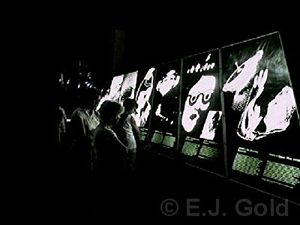 My right arm through all this was Raymond Lefebvre of Presentation Design, a company in Ville Laval outside Montreal which had worked on the pavilion almost since its beginnings, knew it inside out and charged very reasonable fees. Raymond helped me in uncountable ways and was always so incredibly positive and pleasant to work with. From him I learned good work habits which have served me extremely well. Even when he was apparently angry he was fun to work with. We have remained friends to this day.
My right arm through all this was Raymond Lefebvre of Presentation Design, a company in Ville Laval outside Montreal which had worked on the pavilion almost since its beginnings, knew it inside out and charged very reasonable fees. Raymond helped me in uncountable ways and was always so incredibly positive and pleasant to work with. From him I learned good work habits which have served me extremely well. Even when he was apparently angry he was fun to work with. We have remained friends to this day.
Anyway, I was saying that one fine day, I was inspired by an article in OMNI and decided to take matters into my own hands. I would make the alien myself based on the most widespread descriptions of witnesses. I knew exactly what I was going to do. So one night, after coming home from work, I went with Raymond to the hardware store and art supply store and purchased the necessary materials. Raymond helped me set up my armature and got me started.
For weeks I worked on the sculpture in my studio at the front of my spacious seven room apartment in an old building in Montreal. Slowly the sculpture took shape and began to reflect the image so distinctly imprinted in my mind: big eyes, small nose, high cheek bones, slightly oriental look, small mouth, ears, and large cranium—this guy had brains. I wondered how come it was so clear... How come I knew so well what I was doing? Where did the image come from? Was it from the past? Was it from the future? Was it future man? Was I plugging into what we were destined to become? Was I sculpting what was already imprinted in my genetic code? Was it fed to me by aliens who were delighted with what I was doing? Was I doing as great a PR job for them as I was for the US government with my space exhibit? Was I being the willing servant of aliens? Was I chanelling an alien? Was I helping or hindering the cause? I had no answers to these questions. In any case, I began to call my sculpture the Man of My Dreams because, whatever its nature, it came from the depths of my unconscious, had a profoundly eerie quality, and represented something very real somewhere.
Raymond checked in from time to time to see how I was doing. He encouraged me throughout the sculpting process and found me rather brave and adventurous... Determined... is the word I would use. Yes, it was quite adventurous, and the adventure continues to this day. It was also very naive. I had no idea what impact the exhibit would have, once installed...
So the day came when the clay sculpture was complete and ready for the next step. Satisfied that it looked exactly like what I had imagined it, I packaged it up very carefully—it weighed a ton—and sent it off to the Tussaud wax museum where an elderly gentleman, whose name I am afraid I have forgotten, agreed to do it on his own time, since Tussaud’s wasn’t in the habit of making wax molds for anyone other than themselves. He had found the subject rather fascinating and did it quite enthusiastically. In fact, he was so enthusiastic that he even went ahead and made some hands which, in my own fascination with the head, I had completely overlooked. He was so impressed with the sculpture that he wanted to do it justice, and he did. I thank him for his contribution to helping the Man of My Dreams become the international success that it has been, and wish to give him credit for his part. Unfortunately, during the process of going from clay to wax, my original sculpture was destroyed and so I never got it back, to my deep and lasting regret.
I waited holding my breath to see what it would all look like. When it finally came back I breathed a sigh of relief. In fact, I was elated with the results. The head was magnificent. The skin felt real, almost porrous. The texture was perfect. It even had delicate veins around the small mouth, along the cheek bones and on the eyelids. The hands he produced were superb and quite harmonious with the anatomical structure of the mouth. They had little suction cups at the tips of the fingers.
Now we needed a body! So off we went to the warehouse which housed several thousand square feet of exhibit props. We scoured the shelves until we found a small diving suit with boots and a small mannequin to fit inside. The first thing we did after that was get a can of spray paint and spray it greenish gold. It looked great! Straight out of a science fiction movie! We assembled the mannequin and suit and made sure the neck and arms fit neatly. There was no problem. The Man of My Dreams was ready for the world.
When it came time to do the final installation, we had decided to place it in a large aluminum and plexi case that had, at one point, been used to display the Cardiff Giant exhibit and which had been designed by the brilliant Michel Lambert, who made all of the other modules in the pavilion. It was a fabulous display case in the shape of a capsule with metal tips, a round clear body with a slab of black plexi glass in the middle on which we could place the mannequin. It was very high tech looking, and had large bolts holding it together. The case was actually a large horizontal and three-dimensional light-box, so we opaqued the center part and installed text at both ends leaving plenty of room for a small mannequin. The effect was even startling to us. It reminded one of an operating table. It was very clinical, cold, and stark. I think what it did was trigger all sorts of fears and beliefs, deep unconscious memories of the abduction setting for some, futuristic nightmares of human experiments on aliens, and who knows what other scenarios.
The effect of this display can perhaps only be measured by the strange life of its own that it has taken on over the years. I was stunned to hear, as I wandered through the pavilion troubleshooting, what visitors would say about the Man of My Dreams...
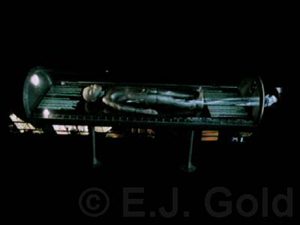 Wax reproduction of an original sculpture by L. Corriveau displayed in Strange, Strange World, 1978-1981
Wax reproduction of an original sculpture by L. Corriveau displayed in Strange, Strange World, 1978-1981
|
I had wanted to achieve a high degree of realism. I had wanted the figure to look believable and not be hoaky. I had wanted to confront visitors with the inescapable reality of other presences and give them a shock. I certainly succeeded at that. Many visitors believed the figure was an actual corpse and would whisper as they walked beside the case, and talk about it as if it were the real one. I was amazed at this response but pleased that my exhibit had an effect that went way beyond my wildest dreams. I guess that’s when the myth started, when independent of the information, the emotional impact struck a chord of truth that has propelled the Man of My Dreams on a life of his own ever since.
When Dr. Hynek visited the pavilion as my guest speaker in 1978, he was struck by the figure and asked if he could have some photos of it, which I of course gladly supplied in the standard Press Packet anyway. In 1979, Stanton Friedman was my guest lecturer which meant that he came and visited the exhibit, as my guest, and also had the opportunity to view my alien in its eight-foot long display case at that time.
I learned from Christian Page, formerly of the now-defunct UFO Quebec, that Stanton Friedman, the Roswell specialist, told Christian that he didn’t know what he was talking about and that this alien could not be part of an exhibit in Montreal. How remarkable and baffling that he could not recall having been there, and asserted so categorically that this place never existed!
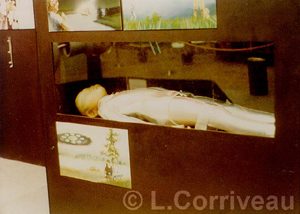 Wax reproduction of an original sculpture by L. Corriveau displayed in Strange, Strange World, 1978-1981
Wax reproduction of an original sculpture by L. Corriveau displayed in Strange, Strange World, 1978-1981
|
I just found out this evening as I was writing this page that Christian Page, one of those around whose name a "copyright issue" was raised as the web site was being developed, is the photographer whose two images have been circulating around the globe, and is also someone I met in 1981 and to whom I provided a personal guided tour, during which he took some of these now-famous and widely-circulated photographs. It is those photos which have been printed in dozens of publications. Christian has probably been the only archivist of the Man of My Dreams and has amassed a substantial collection of newspaper clippings, books, magazines and videos related to him. He made one of these photographs available to the Fortean library with the caveat that they distribute it only when it is accompanied by the correct caption explaining its proper context, just as our photos may only be reproduced with correct caption as given here. Christian was very forthcoming and delighted that we were attempting to clear up the situation once and for all. He has tried to do so for many years but has never been able to. That is yet another reason why it seemed appropriate to come out of the closet. By having the artist talk about the sculpture, by presenting the full context from the point of view of the creator, then a new facet can emerge in this saga which could potentially throw a spin on the focus and fixation of the "true believers".
That is all I have to say for the moment about the Man of My Dreams and how he came back to haunt me. Now I would like to continue my grand tour of Strange, Strange World, and proceed down the mezzanine to the archaeological section.
 Some famous cases were explored from Betty and Barney Hill to Travis Walton. Exhibits presented a wide range of material, including the categories of Close Encounters of the First, Second and Third Kind. In fact, excerpts from Close Encounters of the Third Kind by Steven Spielberg were presented to a huge success. It was a dramatic addition to the exhibit in my main theatre (there were three theatres in all, aside from smaller projections that were incorporated in display cases), with 20 minutes of the best sequences to enthrall visitors. We even attempted to borrow the model of the Mothership from Steven Spielberg but he had his eyes on the Smithsonian Institution, so we were out of luck on this one. But we weren’t out of luck with our celebrity guests.
Some famous cases were explored from Betty and Barney Hill to Travis Walton. Exhibits presented a wide range of material, including the categories of Close Encounters of the First, Second and Third Kind. In fact, excerpts from Close Encounters of the Third Kind by Steven Spielberg were presented to a huge success. It was a dramatic addition to the exhibit in my main theatre (there were three theatres in all, aside from smaller projections that were incorporated in display cases), with 20 minutes of the best sequences to enthrall visitors. We even attempted to borrow the model of the Mothership from Steven Spielberg but he had his eyes on the Smithsonian Institution, so we were out of luck on this one. But we weren’t out of luck with our celebrity guests. By the time visitors got through with the lower section of the exhibit, they had probably noticed that the environment was pitch black except for lighting coming from the displays and a few strategic emergency lights just to stay ahead of any risk of tripping, but it was rather dark around the escalator and one didn’t know where it was leading. Up the escalator which ran alongside the Saturn 5 rocket model, visitors landed on the mezzanine which was devoted to the explosive theme of UFOs and extra-terrestrial encounters. At the top of the escalator they were greeted on the right by aluminum robots slightly reminiscent of Robbie the Robot, and on their left by a Close Encounter of the Third Kind in the form of a strip of pavement with a creature walking along the road and a UFO hovering above it. This was a very effective exhibit with dramatic lighting and a spooky mood that was already in place before my arrival and stayed there to the end. A classic full of punch that needed only the handy telephones to pick up and listen to for a little background information.
By the time visitors got through with the lower section of the exhibit, they had probably noticed that the environment was pitch black except for lighting coming from the displays and a few strategic emergency lights just to stay ahead of any risk of tripping, but it was rather dark around the escalator and one didn’t know where it was leading. Up the escalator which ran alongside the Saturn 5 rocket model, visitors landed on the mezzanine which was devoted to the explosive theme of UFOs and extra-terrestrial encounters. At the top of the escalator they were greeted on the right by aluminum robots slightly reminiscent of Robbie the Robot, and on their left by a Close Encounter of the Third Kind in the form of a strip of pavement with a creature walking along the road and a UFO hovering above it. This was a very effective exhibit with dramatic lighting and a spooky mood that was already in place before my arrival and stayed there to the end. A classic full of punch that needed only the handy telephones to pick up and listen to for a little background information. A model of an immense space station from the realms of science fiction was produced by two lively teenagers adept at modelmaking and very bright eyed and bushy tailed. One of them, Joel Champetier, an award-winning science fiction writer today has since become the editor of Solaris, the french language science fiction magazine published in Quebec which, at the time of this exhibit, was edited by Norbert Spehner who was also the official writer for Strange, Strange World whose job I envied years ago but quickly forgot about once I got busy. It was a harmonious collaboration in every way. Norbert, a college professor and founding Solaris editor, was extremely competent and well-informed. He flowed with my slightly new direction, and was brilliant at getting down on paper a synthesis of all I had assembled during my many months of research when I prepared the exhibit during the off-season.
A model of an immense space station from the realms of science fiction was produced by two lively teenagers adept at modelmaking and very bright eyed and bushy tailed. One of them, Joel Champetier, an award-winning science fiction writer today has since become the editor of Solaris, the french language science fiction magazine published in Quebec which, at the time of this exhibit, was edited by Norbert Spehner who was also the official writer for Strange, Strange World whose job I envied years ago but quickly forgot about once I got busy. It was a harmonious collaboration in every way. Norbert, a college professor and founding Solaris editor, was extremely competent and well-informed. He flowed with my slightly new direction, and was brilliant at getting down on paper a synthesis of all I had assembled during my many months of research when I prepared the exhibit during the off-season.


